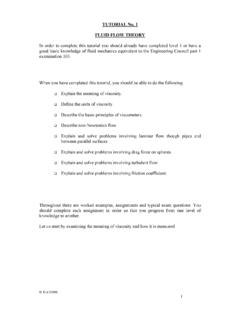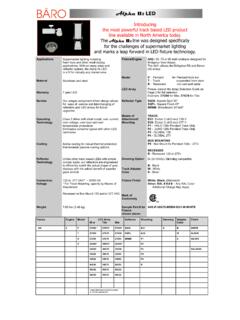Transcription of APPLIED THERMODYNAMICS REVISION OF ISENTROPIC …
1 1 APPLIED THERMODYNAMICS TUTORIAL 1 REVISION OF ISENTROPIC EFFICIENCY ADVANCED STEAM CYCLES INTRODUCTION This tutorial is designed for students wishing to extend their knowledge of THERMODYNAMICS to a more advanced level with practical applications. Before you start this tutorial you should be familiar with the following. The basic principles of THERMODYNAMICS equivalent to level 2. Basic steam cycles, mainly the Rankine and Carnot cycles. Fluid property tables and charts mainly a set of standard thermodynamic tables and a h - s chart for steam which you must have in your possession. The use of entropy. On completion of the tutorial you should be able to understand ISENTROPIC efficiency for turbines and compressors.
2 Describe the use of process steam. describe the use of back pressure turbines. describe the use of pass out turbines. solve steam cycles involving pass out and back pressure turbines. describe the use of feed heating and superheating in steam cycles. solve problems involving feed heating and re-heating. You may be very familiar with all these studies in which case you should proceed directly to section 2. For those who wish to revise the basics, section 1 should be completed. This covers entropy. ISENTROPIC processes. property diagrams. ISENTROPIC efficiency. 2 1. REVISION OF ENTROPY DEFINITION Entropy is a property which measures the usefulness of energy.
3 It is defined most simply as dS= dQ/dT where S is entropy T is temperature Q is heat transfer The units of entropy is hence J/k. The units of specific entropy are J/kg K. ISENTROPIC PROCESS ISENTROPIC means constant entropy. Usually (but not always) this means a process with no heat transfer. This follows since if dQ is zero so must be dS. A process with no heat transfer is called ADIABATIC. An adiabatic process with no friction is hence also ISENTROPIC . PROPERTY DIAGRAMS The two most commonly used property diagrams are i. Enthalpy - Entropy (h - s) diagrams and ii. Temperature - Entropy (T - s) diagrams. h-s diagrams are commonly used for steam work. The diagram will hence show the saturation curve. You should familiarise yourself with the h-s diagram for steam and ensure that you can use it to find values of h and s for any pressure, temperature or dryness fraction.
4 T-s diagrams are commonly used for gas. ISENTROPIC EFFICIENCY Real expansion and compression processes have a degree of friction and this will generate heat which is in effect a heat transfer. increase the entropy. make the final enthalpy bigger than it would otherwise be. make the final temperature bigger than it would otherwise be if it is a gas or superheated vapour. 3 An adiabatic process with friction has no external heat transfer ( Watts or Q Joules) but the internal heat generated causes an increase in entropy. Consider the expansion and compression processes on and 2. The ideal change in enthalpy is h2' - h1 The actual change is h2 - h1 The ISENTROPIC efficiency is defined as hhhh (ideal)h (actual) h1'212is = = for an expansion.
5 Hhhh (actual)h (ideal) h1212'is = = for a compression. In the case of a perfect gas h = cpT hence TTTT1'212is = for an expansion TTTT 1212'is = for a compression Note that for an expansion this produces a negative number on the top and bottom lines that cancels out. 4 WORKED EXAMPLE A steam turbine takes steam at 70 bar and 500oC and expands it to bar with an ISENTROPIC efficiency The process is adiabatic. The power output of the turbine is 35 MW. Determine the enthalpy at exit and calculate the flow rate of steam in kg/s. Note you need the tables and h-s chart for steam. SOLUTION h1= 3410 kJ/kg (tables) s1= kJ/kg K for an ideal expansion s1=s2' Assuming that the steam becomes wet during the expansion, then s2'= sf +x'sfg.
6 At bar = + x' (tables) x' = Note if x' is larger than 1 then the steam is still superheated and the solution does not involve x. Now find h2'. h2' = hf + x'hfg. at bar h2'= 192 + ( )(2392) = kJ/kg. Ideal change in enthalpy h' = - 3410 = kJ/kg actual change in enthalpy h = ( ) = - kJ/kg actual change in enthalpy h = (h2 - h1) = h2 -3410 = h2 = kJ/kg From the steady flow energy equation (with which you should already be familiar) we have + P = H/s Since there is no heat transfer then this becomes P = H/s = m (h2 - h1) P = m( ) = -35 000 kW hence m = kg/s (Note the sign convention used here is negative for energy leaving the system) 5 WORKED EXAMPLE A gas turbine expands gas from 1 MPa pressure and 600oC to 100 kPa pressure.
7 The ISENTROPIC efficiency The mass flow rate is 12 kg/s. Calculate the exit temperature and the power output. Take cv = 718 J/kg K and cp = 1005 J/kg K SOLUTION The process is adiabatic so the ideal temperature T2' is given by T2'=T1(rp)1-1/ rp is the pressure ratio rp = p2/p1 = = cp /cv = = T2 '=873( )1-1 = K Now we use the ISENTROPIC efficiency to find the actual final temperature. is =( T2 - T1)/(T2' - T1) = (T2 - 873)/( - 873) T2 = K Now we use the SFEE to find the power output. + P = m cp(T2 - T1) The process is adiabatic = 0. P = 12( )( - 873) = - 4672 kW (out of system) 6 SELF ASSESSMENT EXERCISE 1.
8 Steam is expanded adiabatically in a turbine from 100 bar and 600oC to bar with an ISENTROPIC efficiency of The mass flow rate is 40 kg/s. Calculate the enthalpy at exit and the power output. (Ans. 51 MW) 2. A gas compressor compresses gas adiabatically from 1 bar and 15oC to 10 bar with an ISENTROPIC efficiency of The gas flow rate is 5 kg/s. Calculate the temperature after compression and the power input. (Ans. MW) Take cv = 718 J/kg K and cp = 1005 J/kg K 7 2. BACK-PRESSURE AND PASS-OUT TURBINES It is assumed that the student is already familiar with steam cycles as this is necessary for this tutorial.
9 If an industry needs sufficient quantities of process steam ( for sugar refining), then it becomes economical to use the steam generated to produce power as well. This is done with a steam turbine and generator and the process steam is obtained in two ways as follows. By exhausting the steam at the required pressure (typically 2 bar) to the process instead of to the condenser. A turbine designed to do this is called a BACK-PRESSURE TURBINE. By bleeding steam from an intermediate stage in the expansion process. A turbine designed to do this is called a PASS-OUT TURBINE. The steam cycle is standard except for these modifications. BACK-PRESSURE TURBINES The diagram shows the basic circuit. The cycle could use reheat as well but this is not normal.
10 Figure 3 8 WORKED EXAMPLE For a steam circuit as shown previously, the boiler produces superheated steam at 50 bar and 400oC. This is expanded to 3 bar with an ISENTROPIC efficiency of The exhaust steam is used for a process. The returning feed water is at 1 bar and 40oC. This is pumped to the boiler. The water leaving the pump is at 40oC and 50 bar. The net power output of the cycle is 60 MW. Calculate the mass flow rate of steam. SOLUTION Referring to the cycle sketch previous for location points in the cycle we can find: h2= 3196 kJ/kg s2 = kJ/kg K For an ideal expansion s1 = s2 = = sf +x'sfg at 3 bar = + x'( ) x' = h4 = hf + x'hfg at 3 bar h4 = 561 + (2164) h4 = kJ/kg ideal change in enthalpy = - 3196 = -612 kJ/kg actual change in enthalpy = (-612) = kJ/kg The power output of the turbine is found from the steady flow energy equation so : P = m( ) kW P = m kW (output) Next we examine the enthalpy change at the pump.



